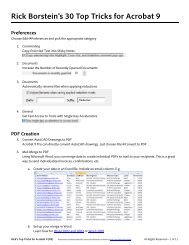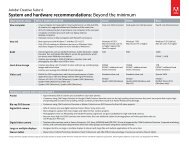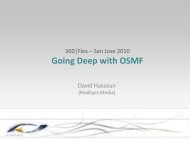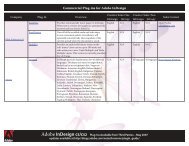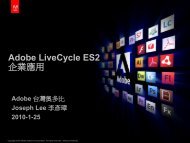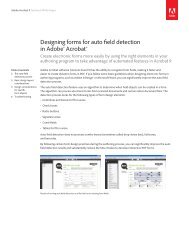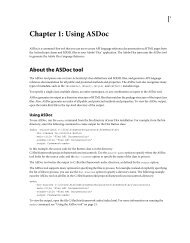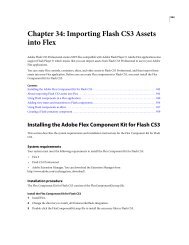Using Adobe® Flex® 4 - Adobe Blogs
Using Adobe® Flex® 4 - Adobe Blogs
Using Adobe® Flex® 4 - Adobe Blogs
- TAGS
- using
- adobe
- blogs
- blogs.adobe.com
Create successful ePaper yourself
Turn your PDF publications into a flip-book with our unique Google optimized e-Paper software.
Resolved code-reference.<br />
<br />
<br />
<br />
<br />
<br />
<br />
<br />
<br />
@font-face {<br />
src:url("../assets/MyriadWebPro.ttf");<br />
fontFamily: myCFFFont;<br />
embedAsCFF: true;<br />
}<br />
.myCFFStyle {<br />
fontSize: 32;<br />
fontFamily: myCFFFont;<br />
}<br />
<br />
<br />
<br />
<br />
<br />
<br />
<br />
<br />
USING FLEX 4<br />
Fonts<br />
The Halo DataGrid control has a special class, TLFDataGridItemRenderer, that you can use for custom item renderers.<br />
The TLFText.css file specifies it as follows:<br />
defaultDataGridItemRenderer:<br />
ClassReference("mx.controls.dataGridClasses.TLFDataGridItemRenderer");<br />
Some controls are not affected by the TLFText.css theme. This is because some Halo controls have Spark equivalents.<br />
As a result, you should use the Spark version of the control instead of the Halo version where possible.<br />
Rather than use the TLFText.css theme file to add FTE support to your Halo controls, you can manually replace the<br />
non-FTE classes with the FTE classes for text rendering on a Halo control. You do this by setting the value of the<br />
textFieldClass or textInputClass style properties to the UITLFTextField or TLFTextInput classes, as the<br />
following example shows:<br />
27



